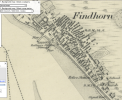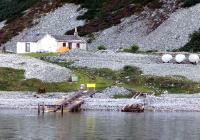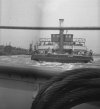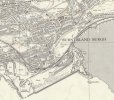ikcdab
Member
Watchet is in there. It had two railways, the GWR and the WSMR.Was there a line into Watchet harbour off the WSR?
Whitby.
Watchet is in there. It had two railways, the GWR and the WSMR.Was there a line into Watchet harbour off the WSR?
Whitby.
Totnes Quay, once served by its own horse-worked branch?In Devon Teignmouth, Exmouth and Topsham had harbour branches as well as Exeter City Basin. Plymouth, of course had extensive dock working. but not in the 'small' category.
Certainly both Portreath and Burghead harbours have basins about two-thirds the size of Newquay harbour and both were rail served. I think the old pier at Findhorn had a siding of the hilariously uneconomic (it closed in 1869 after less than a decade) Findhorn Railway, certainly the line ran to the heads of both piers. If that counts as a harbour railway (doubtful, IMO!) it'll be hard to beat.

Calstock Quay was connected via an incline railway to the Callington line a short distance before the present Gunnislake station. Its route can still be traced. The wagon hoist was a later addition and oou by 1933.Calstock Quay on the tidal River Tamar must be in with shout. Only reached by a single wagon hoist over 100 feet high from the railway viaduct. Main line wagons were moved to and from the quay by horses.
At one time, relative to general traffic in the area, an awful lot.
Yes, it had, the WSR tracks at the Western Pier and GWR tracks at the Eastern Pier.
I'm curious how much traffic these small harbours can provided.
I mulled over that one, as it strays off "harbour" and towards quayside facilities.Matchwood military port?

Don't forget import and export traffic - that might have filled a second van on a busy day!This is a really small port and pier, had the railway company really investigated the potential traffic? I doubt very much if the catch from all those fishing boats at Findhorn could fill a railway van.
It was only rail-served in that North Woolwich station was across the road from the pier entrance. This pier was built by the GE as a ferry terminus of a service to the main part of Woolwich on the south side of the river. (The railway reached N Woolwich a couple of years before trains reached the town centre.).....On a similar vein:
North Woolwich (GER) had a rail served jetty, over the north bank of the Thames. Jetty was still extant, although fenced off and dilapidated, when Iived a stone's throw from it 2006 to 2012.

Wells definitely had freight traffic, and the channel is to the harbour., still used as such to this day.I wonder if Wells next the Sea could be in with a chance? https://maps.nls.uk/view/101167784 shows a siding from the station to the quay at the head of a channel from the N Sea.
Harbours are not only man-made - there are many natural harbours as well. I think what you are trying to define is a port.This is bit of a case of ‘define a harbour’. What about a tidal wharf with a siding on it, for example?
At one time Burntisland was the second largest port on the Forth after Leith! Even today it's hardly smallBurntisland
I can't find any trace on old maps, in my histories of the North Woolwich branch or of Woolwich of such a jetty. (I was a resident of Woolwich 1946-1977)Thanks John. That photo seems to show the pier opposite the erstwhile station, as you say.
The jetty I refer to, is/was halfway along Victoria ornamental gardens.
Unfortunately the OP saidHas anyone mentioned St Michaels Mount Cornwall. Narrow gauge wagonway.
We haven't actually agreed - or been given a steer on - whether we are looking for the smallest artificially enclosed area of water, or the shortest quay (see Wells-next-the Sea above.)"When I was reading about Newquay, a very small harbour that can only accommodate brigs and boats, but which once had a standard gauge harbour railway, I wondered if it was the smallest harbour in the UK to have had a harbour railway? At least in standard gauge system."
but both of those are really big harbours/ports - well, maybe not Folkestone! The fun in this is finding a tiny place with rails alongside a quay...Does Holyhead count with the railway on the breakwater? Home to class 01 shunters.
Folkestone had tracks on the pier beyond where passenger trains stopped. Never saw a train on them. The long boat trains went off the juice rail and onto the unelectrified tracks.
The tracks on the pier were like tram tracks set in concrete. Enough EMU stayed on the juice rail for it to start back up to Folkestone East.
Memories from when I was a nipper so may not be quite right.
Gibraltar Dockyard did have an internal railway. I once owned a nameplate from 'Calpe', one of the Hunslet tank locos to judge by the picture I once had. No idea of gauge, but the RN were 2'-6" fans.Being connected to a wider rail network probably isn't necessary, since one could imagine a large port complex with significant internal traffic being otherwise disconnected from the main line railway. I don't know if Gibraltar dockyard had an internal rail network, but if so it would qualify here. Of course, such a harbour is also unlikely to be small.
Metre gauge - as was Singapore Dockyard.Gibraltar Dockyard did have an internal railway. I once owned a nameplate from 'Calpe', one of the Hunslet tank locos to judge by the picture I once had. No idea of gauge, but the RN were 2'-6" fans.
Pat
Ironically Eling (not Ealing) Wharf is now part of ABP Southampton’s rather large estate.Burry Port, South Wales ?
Ealing Wharf (on short branch from Totton) might count
What about Glasson Dock. It had 2 railways to it for a time.but both of those are really big harbours/ports - well, maybe not Folkestone! The fun in this is finding a tiny place with rails alongside a quay...
[Spoiler alert!]
I'm reminded of the potential (German) invasion embarcation ports described in
"The Riddle of the Sands!"
It’s worth remembering that prior to the opening of the Forth Bridge, ferry-trains (from Leith/Granton?) took passengers across the Firth to connect with and continue their rail journeys northwards.At one time Burntisland was the second largest port on the Forth after Leith! Even today it's hardly small

